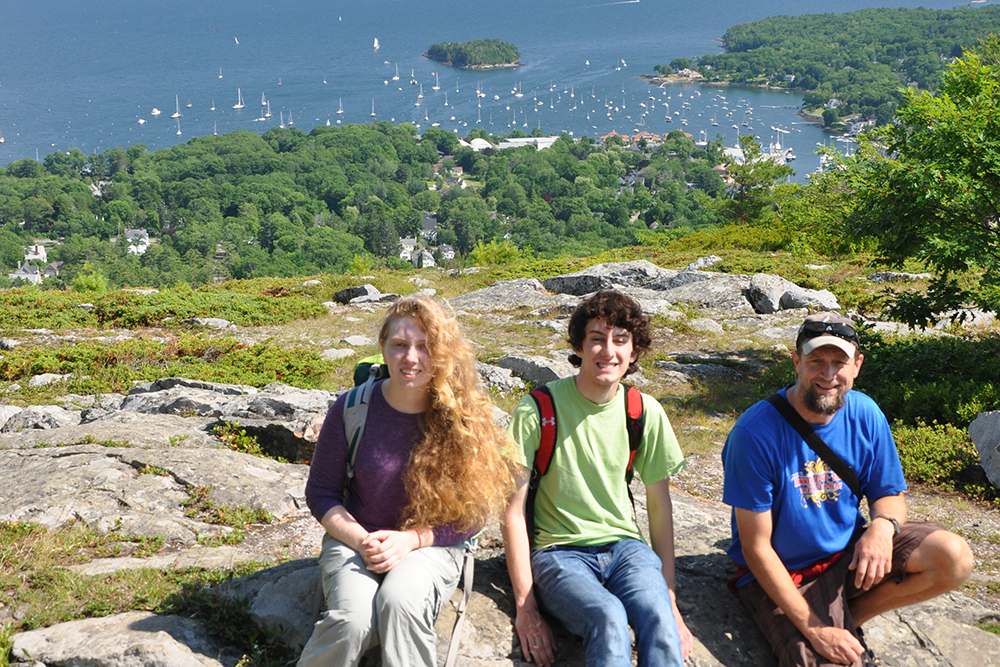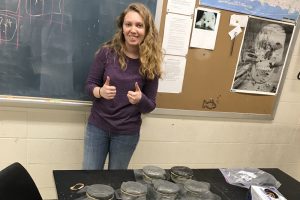Are pesticides aiding an invasive species? ReginaLena McManus ’19 conducted research to see if a tolerance to pesticides might be helping Asian shore crabs push out native crabs on Long Island shores.

ReginaLena McManus, along with her classmate Keith McManus (no relation), and Aaren Freeman, PhD. The photo was taken in Maine, where Dr. Freeman had taken his marine biology class for field collection and laboratory experiments.
As January cold descended on New York and her classmates huddled inside for warmth, ReginaLena McManus ’19, then a senior biology and anthropology double major, spent her break outside on the frigid Jamaica Bay shoreline catching crabs—for science.
She walked the Long Island beach, turning over rocks and grabbing the crustaceans that scrambled out—both native mud crabs and Asian shore crabs, an invasive species that first appeared in U.S. waters in 1988 off the coast of New Jersey, where they are believed to have arrived as larvae in ballast water discharged from cargo ships that had sailed from Japan, Korea and China. McManus planned to take them back to a lab to see how each species reacted to pesticides that contaminate the shoreline ecosystem.
McManus grew up on the coast in Rockaway Park, New York. “I’ve always been really fascinated with marine life and the ocean,” she said. “I thought it would be interesting to see if the Asian shore crabs have a tolerance to pesticides the local mud crabs don’t. It might be a reason the non-natives are pushing out the local species, and if it was, I could maybe get information that could be used to come up with management policy.”
 Back at a lab at Adelphi, McManus exposed the crabs to the pesticide malathion, a pesticide used on farms and around people’s homes to kill a range of insects from mosquitoes to fruit flies. This pesticide finds its way into bays and rivers via runoff, where it’s believed to be impacting sea life. She found there was no significant difference in malathion tolerance between the two species when comparing the levels of acetylcholinesterase, an enzyme that breaks down the neurotransmitter acetylcholine.
Back at a lab at Adelphi, McManus exposed the crabs to the pesticide malathion, a pesticide used on farms and around people’s homes to kill a range of insects from mosquitoes to fruit flies. This pesticide finds its way into bays and rivers via runoff, where it’s believed to be impacting sea life. She found there was no significant difference in malathion tolerance between the two species when comparing the levels of acetylcholinesterase, an enzyme that breaks down the neurotransmitter acetylcholine.
McManus presented her findings at Adelphi’s Research Day, where her project won an Outstanding Presentation Award in the biology category.
For her experiment, McManus clipped off one claw each on 12 native mud crabs and 12 Asian shore crabs. She put 16 crabs in dishes with varying concentrations of malathion, eight in 250ppb (parts per billion) and eight in 500ppb, and eight crabs in plain sea water, leaving them for 48 hours.
She then clipped off each crab’s other claw and compared the tissue with the tissue from the other claws that weren’t exposed to malathion. She was looking for evidence of the activity levels of acetylcholinesterase, which would indicate whether malathion had affected the crabs’ nervous systems. There was some significant difference when looking at the tissues after exposure; however, after looking at the data as a whole, there wasn’t enough evidence to suggest a difference in malathion tolerance between the species.
While her results weren’t conclusive, McManus—who worked on the project with Aaren Freeman, PhD, associate professor and graduate coordinator of the environmental studies program at Adelphi—still feels she is on to something.
“Science is a process that involves a lot of trial and error, so I think that more research is definitely called for,” McManus said. “Researchers might look at behavioral rather than just physiological differences between the species. We designed an experiment using only tissue from claws, so others might try using tissue from the crabs’ bodies. It takes a lot of effort to learn what works.”
McManus wants to use her dual degrees in anthropology and science in a career that focuses on urban shore issues. “I’m interested in marine science and policy,” McManus said.
She is also interested in teaching and was designated an alternate for the Fulbright English Teaching Assistant program for Thailand for the 2019–2020 year. She would have been promoted to finalist status had additional funding become available.
McManus believes education is essential in raising public awareness of threats to the environment, as is the need to gather knowledge to inform the management of coming environmental changes brought about by rising seas and water pollution.
For further information, please contact:
Todd Wilson
Strategic Communications Director
p – 516.237.8634
e – twilson@adelphi.edu